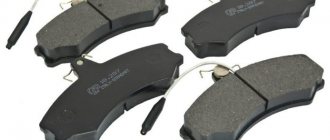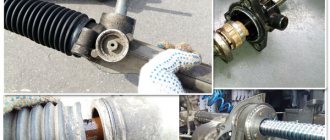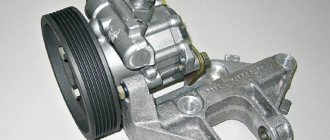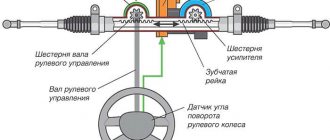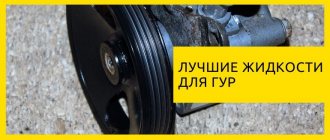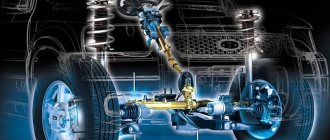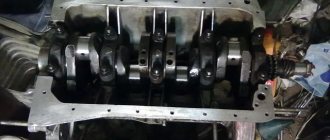A creaking sound when turning the steering wheel is the first sign of a car malfunction, to which the motorist must pay attention. This kind of breakdown can threaten the life and health of the motorist and his passengers. If a malfunction is noticed, the first thing to do is carry out diagnostics and contact a car service center.
The steering wheel is the main control mechanism of the car, and if you hear any extraneous noise in it, you must definitely eliminate it.
It is important to avoid the phrase “it will endure”, since when subjected to wear, a broken part can harm neighboring mechanisms. As a result of this, operating mechanisms may jam, and while driving, this breakdown may cost the life of the driver and passengers. Therefore, it would not be superfluous to conduct a full inspection and computer diagnostics of all parts of the car. Find out the cost of diagnosing your steering system online in 3 minutes.
Don’t waste your time - use the Uremont search and get offers from nearby services with specific prices!
Get prices
There are many reasons for the occurrence of extraneous noise; when turning the steering wheel, it is important to take into account that this is a complex mechanism, which means that breakdowns will have a different nature. The noise may also vary depending on whether the steering wheel has hydraulic or electric steering assist. In any case, you need to carry out high-quality diagnostics at the nearest car service center. To make the work easier, the specialist should explain in detail the nature of the noise and under what circumstances it occurs. It is necessary to perform a number of actions when driving and also when parking the car.
Let's dwell on the topic of diagnostics. How to explain to a mechanic exactly what the problem is with the steering mechanism? First of all, you need to try to answer the following questions:
- What is the frequency of the squeak and its character?
- Is there a difference in road surface?
- When turning in which direction does the noise occur?
- Does the noise go away when weather conditions change?
If you are not prepared for such questions, it will be difficult to determine why a certain noise occurs. But if everything is done correctly, you can significantly speed up the process of repairing a car, and also make the mechanic’s job easier.
Causes of failure in the steering column
Usually, squeaks when turning the steering wheel while driving occur in several cases, but most often this occurs due to a broken steering column. Also, unwanted sounds and vibrations can be caused by problems with the chassis, brake system, or suspension problem. In any case, these problems require attention, since neglect of such minor breakdowns can lead to costly replacement of parts and components.
What else could be the reason?
In general, when searching for the source of a sound, you must first check all the moving parts that are involved when turning. Also inspect everything that is located near the steering shaft, mechanism, rods, suspension elements, wheels. For example, a loose bolt or self-tapping screw will make strange sounds when it touches moving elements.
There are also more specific causes of squeaks that have nothing to do with the suspension and steering mechanism, but they appear exclusively when turning. For example, the body may be to blame for the sounds. The components of the load-bearing part are connected to each other using spot welding. When the connection points are broken, the elements begin to rub against each other, and not constantly. When moving in a straight line, the components are stationary, but during turns the forces acting on the body change, which leads to friction and, accordingly, squeaks.
To identify the source of the sound, it is not necessary to go to a service station, just drive the car into the inspection hole and ask an assistant to turn the steering wheel in different directions. Being in a hole, you can very easily determine the cause of squeaks. And then you should act based on the results.
It is enough to simply lubricate the rubber elements to temporarily get rid of the sounds. But if the source is a steering mechanism unit, suspension unit or something else, it is advisable to carry out repair work as soon as possible.
When the steering wheel creaks when turning, the driver immediately perceives this sound as a signal to troubleshoot. This is logical, because most often extraneous noise occurs due to a malfunction of any systems or wear of parts. In addition, if the steering wheel creaks when rotating, this creates the risk of an accident, which can lead to dire consequences.
Causes of creaking rack and steering column
If the steering column is not working properly, you will hear a slight knock and noticeable vibration when driving. The cause of this malfunction is a strong mechanical impact on the steering wheel, during sudden braking or a collision during an accident. Such signs indicate deformation of the steering column. Also, strange sounds may come from the coupling.
Of course, the best way to eliminate a squeaking or knocking sound when moving and turning the steering column is to simply replace the non-functioning element with a new part. Unfortunately, the steering column is expensive, which means you need to look for ways to repair the old part. Vibration and noise can be eliminated using lubricant. Lubricating the driveshaft with a small amount of grease can eliminate unwanted noise, but this will only mask the symptoms. It is important to seek help from professionals who can fix the broken part before it completely fails.
Causes of squeaking wheels
There are several known causes of unpleasant noise in a car. Usually you can eliminate the squeaking sound in the right wheel when turning the steering wheel or left, with little cost.
In case of irregularities in the steering column, incorrect wheel alignment, problems with power steering and rod ends, as well as damage to CV joints, repairs must be carried out urgently.
Faulty steering column and rack
The steering rack is the unit responsible for turning the front axle. The column is connected to the wheels by means of rods. If the noise in the suspension area is caused by a faulty steering rack, then this will require serious repairs. Usually in this case one of the rods or both are deformed. Then they begin to cling to some part of the body, which causes a knocking sound when turning the steering wheel or while driving.
An even more dangerous symptom is when the steering mechanism jams or rotates spontaneously, and the vehicle speed is not low. Therefore, if a wheel squeaks when turning, immediately contact a service center! This is a warning to the driver that they need to carefully check the device or look for the cause in other systems and components of the vehicle.
Steering gear
Car wheel alignment
Incorrect toe-in or incorrect wheel mounting angle relative to the road surface also causes noise. The greater the deviation from the factory standards, the louder the squeaking noise is heard when turning and driving straight ahead. It occurs due to the clinging of the fender liner or body to the tire.
The same thing happens with the wrong castor. This is the name given to the inclined rotary angle of the wheel axle, located in the longitudinal plane. The more ideal it is, that is, not positive or negative, the better. Otherwise, a shift to one side is fraught with danger. For example, with excessively positive castor, an unwanted lateral roll is created, which is accompanied by wheel squeaking.
Wheel alignment angles
Power steering problem
The power steering on the steering wheel, of course, helps to drive the car comfortably. However, they gradually began to abandon it in favor of an electric amplifier. One of the reasons is the need to regularly monitor the working fluid. If there is a deficiency or improper refueling (oil of the same color and composition must be used), negative consequences should be expected. A slight hum or hiss is allowed, but not a grinding sound - if you can hear it, this is already a sign of a malfunction.
In addition to noise, power steering malfunctions are judged by the behavior of the steering wheel:
- strong vibration transmitted when passing small potholes and gravel roads;
- slow return to starting position;
- increased play, which negatively affects control - the car drives even on a straight road;
- difficult to turn in one direction or both.
Repair of the steering wheel with power steering must be carried out in specialized workshops. Errors during restoration can easily result in unnecessary costs, additional breakdowns and can lead to an accident.
Power steering rack
You should not trust hydraulic repairs to “left-handed” service stations. Here they often buy used spare parts, from which they assemble one working unit. This allows you to reduce the price of consumables, but buying them is not profitable and dangerous - the unit can break at any time, since its quality is low. In addition, frivolous workshops are rarely equipped with advanced stationary equipment. And without it, it is impossible to compare existing parameters with factory values, find deviations, and evaluate backlash and runout.
Tie Rod Ends
It happens that the steering wheel wobbles when turning, and not only makes a grinding noise - damage to the control joints or tips is possible. They also wear out over time and require replacement. If you do not contact the service station in time, the rod will jam at any moment. What this threatens is not worth describing.
Rusted tie rod end
The rod ends are damaged, as mentioned, due to torn anthers. In this case, the hinges have to be replaced and then their position adjusted. If there are signs of wear on one tip, the entire pair is replaced.
Ball joint and CV joint
The ball joint creaked - this is a sign of its imminent “death”. Often the element connecting the wheel hub and the suspension arm fails due to untimely maintenance. It is extremely important to renew the grease in the working cavity of the unit.
The support makes a dull noise, with a slight vibration transmitted to the body. At first, the unpleasant sound appears rarely, then more and more often, mainly at low speeds. The creaking sound in the front wheel is heard louder when turning the steering wheel.
This sign should not be ignored - when the connection between the lever and the steering knuckle is broken, the car becomes uncontrollable. The result will not be long in coming: a twisted wheel, a deformed fender or door, waiting for a tow truck. This also provided that the speed of the car was insignificant. And if a break happens on the highway, when the speedometer needle has crossed the red zone, only his experience and skill will save a person from serious consequences.
New and rusted ball joints
It is difficult to determine the exact service life of the part - it can last 15 or 120 thousand kilometers. It all depends on the operating conditions. It is more correct to regularly monitor the performance of the ball joint.
The weakest point in the design of the suspension element is the protective boot, which resists dirt and water. Even through a minor crack in it, moisture can penetrate and provoke corrosion with all the ensuing consequences. Therefore, the designers positioned the ball so that it was not easy to mechanically damage it.
Popular brands:
Mazda MPV
More often than not, a part is damaged due to improperly carried out repairs to the chassis or a complete lack of any maintenance. For example, when the grease dries out.
The CV joint can also creak, or rather, crunch. This is a hinge that provides torque transmission at rotation angles of up to 70 degrees relative to the axis. The grenade makes extraneous sounds during production when the bearing balls bite. Again, as in the case of the ball joint, the most vulnerable link here is the boot. First it breaks, and then the internal filling is damaged. Therefore, it is extremely important to monitor the condition of the rubber protection at least 2 times a year.
A damaged CV joint can cause a squeaking wheel.
The malfunction of a specific joint is quickly determined:
- the internal tripoid grenade crunches when starting to move, especially at reverse speed;
- external - on the move with the wheels turned out.
The most correct way to get rid of noise is to replace worn CV joints. If the grenade is 70% worn out or more, washing and replacing the lubricant alone is not enough. It is necessary to check the hinge boots in a timely manner to protect the mechanisms from early damage.
Silent blocks creaking
An equally common cause of unpleasant noise is damage to silent blocks. These are rubber-metal or polyurethane hinges that ensure the mobility of levers, springs and other mechanisms. At the same time, the parts isolate radial, axial, torsion and cardan vibrations.
The main causes of squeaking are wear, improper installation or design features. The usual service life of parts on Russian roads is no more than 50-60 thousand kilometers. A malfunction is detected by the following symptoms:
- cracks and other damage are visible on the element;
- after lubricating the hinge, the creaking resumes after a couple of days;
- The overall controllability of the car deteriorates, the steering wheel responds poorly to the driver’s commands, and vibration occurs in the body.
Worn and dried silent blocks must be replaced
It is recommended to replace worn silent bushings quickly. Otherwise, the load will be transferred to the levers and other elements of the body, which is why they will soon also fail. Thus, the cost of repairs will increase several times.
Bearings creaking
If the left wheel squeaks when turning or the right one when starting to move, somewhere around 60-70 km/h, regardless of the quality of the road surface, it is most likely a wheel bearing. Also, the noise occurs regardless of direction (turning, straight ahead) and its character does not change when braking. It definitely disappears during overclocking.
There are no strict regulations for replacing a wheel bearing. If installed correctly, the part will last 100 thousand kilometers or more. Therefore, the main cause of wear is high mileage. This is also facilitated by careless driving with the wheels periodically falling into holes, causing protective rubber or plastic covers to tear.
Dry front wheel bearing
Creak of rubber elements
Many elements of the chassis and steering are made of rubber. Therefore, the likelihood of squeaking increases. The specific cause of the noise on the lift is identified. If it is not possible to determine the location by ear, computer diagnostics are performed.
Noise when turning the steering wheel in place
The noise is also caused by the banal wear of small parts of the steering wheel. The anthers are often damaged, and dirt and debris accumulate in the mechanisms. This causes a hum when turning the wheel. Finally, the rack may not be adjusted correctly. We are talking about the gap between it and the column. In this case, you must definitely contact a service station, since it is extremely difficult to make such adjustments yourself. This is explained by the fact that each car model has an individual adjustment system.
Problems with the steering rack
The main reason for annoying squeaking noises when turning the steering wheel is a faulty steering rack. Such a squeak can be annoying, and untimely repairs can damage the parts. Unwanted squeaking can occur due to simple wear of the mechanisms, damage to the rack box or wear of the steering tips, which can rub against the rods. In addition, damaged anthers can accumulate dirt and debris, which makes a nasty sound when the mechanism operates.
Also, the cause of an unwanted squeak may be an incorrect setting between the steering rack and the column. It is extremely difficult to make such an adjustment, since all machines have an individual adjustment system, and it is better to trust a specialist.
How to determine the cause of a squeak when turning the steering wheel
The steering mechanism of a car is quite complex, especially if it works in conjunction with a power steering. Because of this, there can be a lot of reasons that lead to squeaking when turning the steering wheel.
Carrying out diagnostic work that will allow you to determine the causes of the squeak should begin with identifying the specific place from which the squeak is heard when turning the steering wheel. To do this, you need to put the car in a hole and ask someone to turn the steering wheel, while listening to sounds from under the car to determine the location of the squeak. Having decided which element is creaking, you can move on to repairs.
Steering wheel creaks in place
Interestingly, squeaking when turning the steering wheel in place, just like with the steering rack, can occur due to damaged steering rod boots. It is the debris and dirt in the protection that can contribute to squeaking when turning the steering wheel. This sound can be heard both while driving and while parked. All you need to do is clean the components from dust and dirt with the familiar WD-40 product, and replace the worn boots with a new and high-quality product. But it’s better not to start everything up, and not to wait until the steering wheel squeaks again, but to periodically check the condition of the boots and, if necessary, replace them.
Important! If the steering wheel not only makes a grinding noise when turning, but also wobbles a little and vibrates, the problem is not only in the steering rod, but also in the steering joint. Such a hinge may wear out over time and require replacement. If you do not replace the part in time, the hinge itself may jam, and you need to be reminded what will happen if the steering wheel starts to jam while driving and turns poorly.
Another reason for squeaking when making turns is an insufficient amount of fluid in the power steering. Typically, such a squeak will only be heard when the steering wheel is turned while the car is stopped. The first thing to do is try to replenish the fluid in the power steering reservoir. If this method does not help, you need to carry out a full diagnosis and, if necessary, repair the pump and other power steering elements. These elements are quite complex to repair at home, so it is better to contact a service station.
Incorrect wheel alignment can also cause a crunching sound every time you turn the steering wheel. Diagnostics and debugging are carried out only in car services, using computer diagnostics. The service will set the exact angle of the wheels, which will not only get rid of squeaking, but also help avoid severe wear of the tire rubber.
Also, a crunching or rubbery squeak when turning the steering wheel may indicate that the ball joints are worn out. If such problems are detected, urgent diagnostics must be carried out. In the event of a breakdown, it is necessary to replace the broken part with a new support. If you can't find a new ball joint, you can use lubricant. This repair will be temporary and will need to be replaced in the future. If you do not replace the ball joint in time, there is a possibility that the wheel will come off at high speed. In this type of accident, it is rare for anyone to escape without injury.
Having learned about a malfunction in the steering part, there is no need to hesitate. It is important to remember under what circumstances the noise occurs and contact a car service center. With correct diagnostics and skillful hands, the car will be on the road again. The steering part is one of the most important parts of the car, so you should not carry out repair work yourself. Finding a quality car service is not easy, but the Uremont.com website makes the search much easier. You just need to submit a request for car diagnostics and select a suitable car service from the list. Thus, you can quickly and easily repair your car thanks to our service.
Problems with ball joints and CV joints
Creaks and knocking noises when turning the steering wheel may appear due to a worn ball joint. Moreover, the ball makes these sounds both when the car is stationary and when it is driving. The support must be replaced immediately, otherwise it may suddenly fail completely at high speed, which is very dangerous. The service life of ball joints (as well as other automotive mechanisms) will increase significantly if the driver uses an adequate driving style, which is especially important when the road surface is poor. It is also worth monitoring the condition of the anthers, this will help to significantly extend their service life.
The torque from the gearbox is transmitted to the wheel. It is in this process that the CV joint, or constant velocity joint, takes part. You can tell that it is out of order by the characteristic creaking (crunching) sound when you turn the steering wheel. Thus, the needle bearing makes its problem known. CV joints are divided into external and internal. In most cases, squeaking in wheels comes from the outer joints.
Even if you know that when you turn the steering wheel, a squeak in the wheel area appears due to the constant velocity joint, do not panic. Sometimes the CV joint can creak for another ten thousand kilometers, and only later requires replacement. It happens that you just need to install a new boot, refresh the CV joint lubricant in order to extend the service life of the mechanism.
Other steering components
When the steering wheel squeaks when rotating, wear of other parts of the steering system cannot be ruled out. In particular, the reasons may be the following:
- Damage to the boots on the steering rod joints. If sand or dirt gets inside due to a leaky boot, this can cause a grinding or characteristic squeak. The integrity of these parts can be checked manually. If they are leaky, they will need to be replaced. It is also worth checking the tie rod end boots. Sand getting into them can also cause the Opel steering wheel to squeak when turning. This also applies to other imported or Russian-made cars.
- Worn steering joints. This problem causes not only a squeak, but also a knocking sound at the initial stage of turning the steering wheel. Worn hinges are never restored, but replaced immediately.
- Lack of lubrication or presence of sand in the steering knuckle bearings. This is accompanied by strong heating of the bearings, which leads to creaking and whistling. The problem is solved by adding lubricant.
